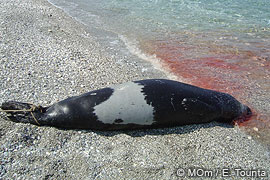Media Watch, The National Parks of the Pacific Islands, July 31, 2010

The following report was received from the Hilo Marine Mammal Response Network:
Unfortunately, a monk seal was attacked by a Pit Bull earlier today (Friday, July 30) in the Kau region. Reports from the NOAA law enforcement agency say the attack lasted for about a minute until the seal retreated into the ocean. The extent of injury is unknown, and very little information is currently known about this matter. If you have any information (location attack may have taken place, name of dog owner, recent seal sightings, etc.) please contact our monk seal line at 808-756-5961, or email hmmrn@hawaii.edu .
Kau, Hilo, Hawaii

 LIHU‘E — Federal authorities are continuing to investigate the cause of death of an endangered Hawaiian monk seal pup found over the weekend on Ni‘ihau.
LIHU‘E — Federal authorities are continuing to investigate the cause of death of an endangered Hawaiian monk seal pup found over the weekend on Ni‘ihau. Venerdì 18 giugno lo staff del diving center “Massub” ha avvistato e fotografato, nella zona B dell’Area Marina Protetta (AMP), un esemplare di foca monaca di poco meno di 2 metri di lunghezza. Questa piacevole ed inaspettata notizia avviene proprio nell’anno internazionale della biodiversità; questa visita dimostra come le AMP siano dei veri e propri “santuari naturali” capaci di tutelare la biodiversità attraendo nuovamente specie scomparse. Ormai undici anni di gestione nell’AMP Portofino fanno sì che alcune specie di pesci (come Epinephelus marginatus), che erano pressoché scomparse, siano ora presenti, e in taglie considerevoli; proprio in questo contesto si inserisce la visita della foca monaca che, essendo ghiotta di grossi pesci non reperibili altrove, crediamo sia stata spinta a visitare la nostra AMP.
Venerdì 18 giugno lo staff del diving center “Massub” ha avvistato e fotografato, nella zona B dell’Area Marina Protetta (AMP), un esemplare di foca monaca di poco meno di 2 metri di lunghezza. Questa piacevole ed inaspettata notizia avviene proprio nell’anno internazionale della biodiversità; questa visita dimostra come le AMP siano dei veri e propri “santuari naturali” capaci di tutelare la biodiversità attraendo nuovamente specie scomparse. Ormai undici anni di gestione nell’AMP Portofino fanno sì che alcune specie di pesci (come Epinephelus marginatus), che erano pressoché scomparse, siano ora presenti, e in taglie considerevoli; proprio in questo contesto si inserisce la visita della foca monaca che, essendo ghiotta di grossi pesci non reperibili altrove, crediamo sia stata spinta a visitare la nostra AMP. It is hard to imagine anyone not being moved by the tragic tale of ‘Markos’ – the young Mediterranean monk seal who was brought into intensive care, struggling for life, but horribly mutilated by the bullet that shattered his jaw and nasal cavity.
It is hard to imagine anyone not being moved by the tragic tale of ‘Markos’ – the young Mediterranean monk seal who was brought into intensive care, struggling for life, but horribly mutilated by the bullet that shattered his jaw and nasal cavity.